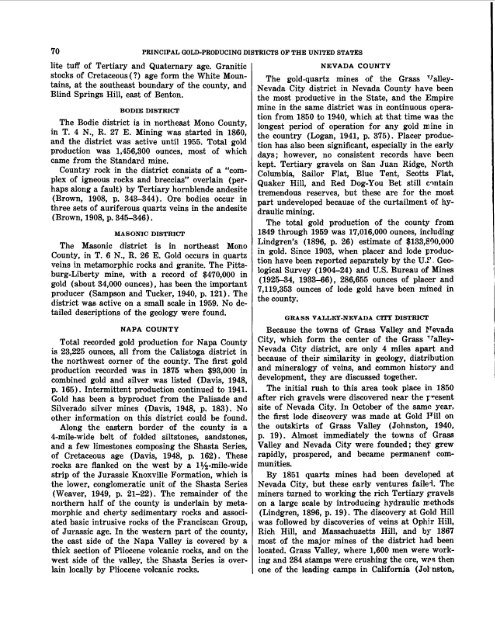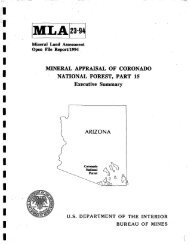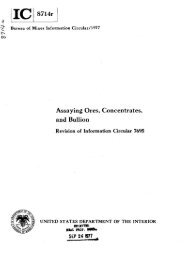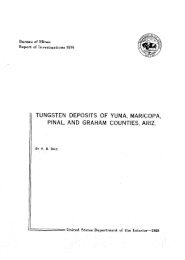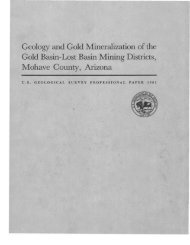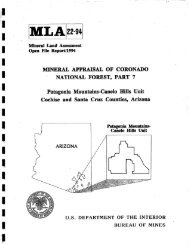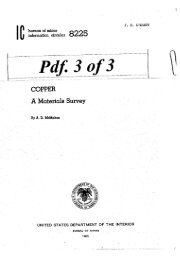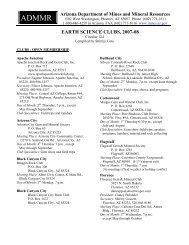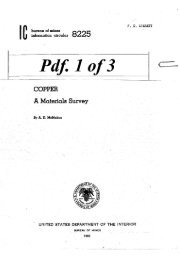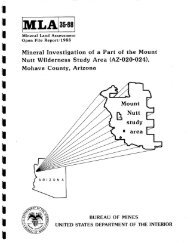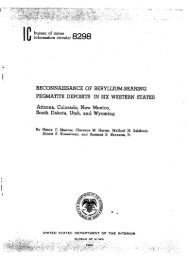here - State of Arizona Department of Mines and Mineral Resources
here - State of Arizona Department of Mines and Mineral Resources
here - State of Arizona Department of Mines and Mineral Resources
You also want an ePaper? Increase the reach of your titles
YUMPU automatically turns print PDFs into web optimized ePapers that Google loves.
70 PRINCIPAL GOLD-PRODUCING DISTRICTS OF THE UNITED STATES<br />
lite tuff <strong>of</strong> Tertiary <strong>and</strong> Quaternary age. Granitic NEVADA COUNTY<br />
stocks <strong>of</strong> Cretaceous (?) age form the White Moun- The gold-quartz mines <strong>of</strong> the Grass ,.,alleytains,<br />
at the southeast boundary <strong>of</strong> the county, <strong>and</strong> Nevada City district in Nevada County have been<br />
Blind Springs Hill, east <strong>of</strong> Benton. the most productive in the <strong>State</strong>, <strong>and</strong> the Empire<br />
BODIE DISTRICT<br />
The Bodie district is in northeast Mono County,<br />
in T. 4 N., R. 27 E. Mining was started in 1860,<br />
<strong>and</strong> the district was active until 1955. Total gold<br />
production was 1,456,300 ounces, most <strong>of</strong> which<br />
came from the St<strong>and</strong>ard mine.<br />
Country rock in the district consists <strong>of</strong> a "complex<br />
<strong>of</strong> igneous rocks <strong>and</strong> breccias" overlain (perhaps<br />
along a fault) by Tertiary hornblende <strong>and</strong>esite<br />
(Brown, 1908, p. 343-344). Ore bodies occur in<br />
three sets <strong>of</strong> auriferous quartz veins in the <strong>and</strong>esite<br />
(Brown, 1908,p.345-346).<br />
MASONIC DISTRICT<br />
The Masonic district is in northeast Mono<br />
County, in T. 6 N., R. 26 E. Gold occurs in quartz<br />
veins in metamorphic rocks <strong>and</strong> granite. The Pittsburg-Liberty<br />
mine, with a record <strong>of</strong> $470,000 in<br />
gold (about 34,000 ounces), has been the important<br />
producer (Sampson <strong>and</strong> Tucker, 1940, p. 121). The<br />
district was active on a small scale in 1959. No detailed<br />
descriptions <strong>of</strong> the geology were found.<br />
NAPA COUNTY<br />
Total recorded gold production for Napa County<br />
is 23,225 ounces, all from the Calistoga district in<br />
the northwest corner <strong>of</strong> the county. The first gold<br />
production recorded was in 1875 when $93,000 in<br />
combined gold <strong>and</strong> silver was listed (Davis, 1948,<br />
p. 165). Intermittent production continued to 1941.<br />
Gold has been a byproduct from the Palisade <strong>and</strong><br />
Silverado silver mines (Davis, 1948, p. 183). No<br />
other information on this district could be found.<br />
Along the eastern border <strong>of</strong> the county is a<br />
4-mile-wide belt <strong>of</strong> folded siltstones, s<strong>and</strong>stones,<br />
<strong>and</strong> a few limestones composing the Shasta Series,<br />
<strong>of</strong> Cretaceous age (Davis, 1948, p. 162). These<br />
rocks are flanked on the west by a 1Y2-mile-wide<br />
strip <strong>of</strong> the Jurassic Knoxville Formation, which is<br />
the lower, conglomeratic unit <strong>of</strong> the Shasta Series<br />
(Weaver, 1949, p. 21-22). The remainder <strong>of</strong> the<br />
northern half <strong>of</strong> the county is underlain by metamorphic<br />
<strong>and</strong> cherty sedimentary rocks <strong>and</strong> associated<br />
basic intrusive rocks <strong>of</strong> the Franciscan Group,<br />
<strong>of</strong> Jurassic age. In the western part <strong>of</strong> the county,<br />
the east side <strong>of</strong> the Napa Valley is covered by a<br />
thick section <strong>of</strong> Pliocene volcanic rocks, <strong>and</strong> on the<br />
west side <strong>of</strong> the valley, the Shasta Series is overlain<br />
locally by Pliocene volcanic rocks.<br />
mine in the same district was in continuous operation<br />
from 1850 to 1940, which at that time was the<br />
longest period <strong>of</strong> operation for any gold mine in<br />
the country (Logan, 1941, p. 375). Placer production<br />
has also been significant, especially in the early<br />
days; however, no consistent records have been<br />
kept. Tertiary gravels on San Juan Ridge, North<br />
Columbia, Sailor Flat, Blue Tent, Scotts Flat,<br />
Quaker Hill, <strong>and</strong> Red Dog-You Bet still c'lntain<br />
tremendous reserves, but these are for the most<br />
part undeveloped because <strong>of</strong> the curtailment <strong>of</strong> hydraulic<br />
mining.<br />
The total gold production <strong>of</strong> the county from<br />
1849 through 1959 was 17,016,000 ounces, including<br />
Lindgren's (1896, p. 26) estimate <strong>of</strong> $133,800,000<br />
in gold. Since 1903, when placer <strong>and</strong> lode production<br />
have been reported separately by the U.f', Geological<br />
Survey (1904-24) <strong>and</strong> U.S. Bureau <strong>of</strong> <strong>Mines</strong><br />
(1925-34, 1933-66), 286,655 ounces <strong>of</strong> placer <strong>and</strong><br />
7,119,353 ounces <strong>of</strong> lode gold have been mined in<br />
the county.<br />
GRASS VALLEY·NEVADA CITY DISTRICT<br />
Because the towns <strong>of</strong> Grass Valley <strong>and</strong> loTevada<br />
City, which form the center <strong>of</strong> the Grass '-'alley<br />
Nevada City district, are only 4 miles apart <strong>and</strong><br />
because <strong>of</strong> their similarity in geology, distribution<br />
<strong>and</strong> mineralogy <strong>of</strong> veins, <strong>and</strong> common history <strong>and</strong><br />
development, they are discussed together.<br />
The initial rush to this area took place in 1850<br />
after rich gravels were discovered near the r··esent<br />
site <strong>of</strong> Nevada City. In October <strong>of</strong> the same year.<br />
the first lode discovery was made at Gold Ifill on<br />
the outskirts <strong>of</strong> Grass Valley (Johnston, 1940,<br />
p. 19). Almost immediately the towns <strong>of</strong> Grass<br />
Valley <strong>and</strong> Nevada City were founded; ther grew<br />
rapidly, prospered, <strong>and</strong> became permanent communities.<br />
By 1851 quartz mines had been developed at<br />
Nevada City, but these early ventures failed. The<br />
miners turned to working the rich Tertiary rravels<br />
on a large scale by introducing hydraulic methods<br />
(Lindgren, 1896, p. 19). The discovery at Gold Hill<br />
was followed by discoveries <strong>of</strong> veins at Ophir Hill,<br />
Rich Hill, <strong>and</strong> Massachusetts Hill, <strong>and</strong> by 1867<br />
most <strong>of</strong> the major mines <strong>of</strong> the district had been<br />
located. Grass Valley, w<strong>here</strong> 1,600 men were working<br />
<strong>and</strong> 284 stamps were crushing the ore, WNl then<br />
one <strong>of</strong> the leading camps in California (Jol'nston,


